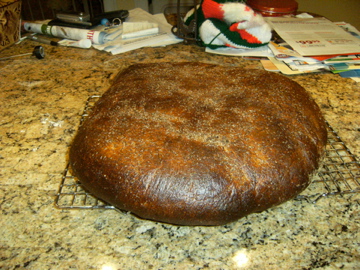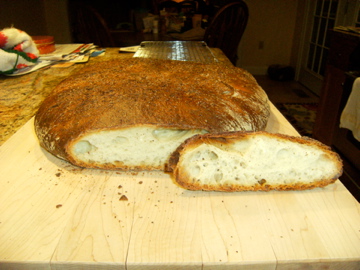

A few years ago, I read a chapter in "It Must Have Been Something I Ate" where Jeffrey Steingarten discussed the lengths that he went through to master Pane Genzanese. The story was so inspiring (and hilarious) that I, who at the time lived in a tiny town in Upstate New York, far from a bakery where one could score a decent loaf of French or Italian bread, decided to buy the BBA, got a big and heavy baking stone, and threw myself headlong into yet another hobby that would become an obsession and threaten to consume ALL of my precious and limited spare time.
Before then, my bread baking had been limited to a one and a half pound loaf bread machine. But, since that reading, I have baked many and varied loaves of bread and visited this site countless times. I finally worked up the nerve to try this BIG, nine and a half cups of flour, four and a half pound loaf, and I can report on it, tonight.
Impressive in it's appearance, the crust is pleasantly bitter and crunchy with a very open crumb, and would be enough to bring to a quite large dinner party. (With only two adult diners and one infant in our house, I will be giving away half of this loaf to a neighbor in order to save me from myself...) Today was a practice run for baking bread to bring with us to my wife's family for Christmas. Yes, the time has come to bake for the extended family, and I am both excited and terrified...
Day of baking will be 9-10 hours, so I start before I have breakfast and even coffee! There will be plenty of time for eating and drinking during the rise.
Recipe for Pane Genzanese adapted from Jeffery Steingarten's "It Must Have Been Something I Ate":
For the biga:
Half cup of day-old bread dough. (If you don't have that, mix 2.25 oz. AP flour, pinch of instant yeast, 1/4 tsp. kosher salt, and 1.5 oz water. Knead and leave covered at room temperature, overnight, to ferment for the next day's baking.)
8 oz. water
9 oz. AP flour (2 cups)
Stir together half the flour and all the water. Gradually work in the day-old dough, breaking it up and working it in piece by piece. When it is well blended, work for another three to five minutes, then set in a bowl, cover with plastic wrap and let rise to double (about 5 or 6 hours.)
To build the bread:
The batch of biga
3 and 1/3 cups water
31.5 oz. AP flour (7 cups)
1 and 1/4 tsp instant yeast
1 and 1/2 tbl salt
And, about a cup of wheat bran flakes, reserved.
Mix half the flour with the water, and gradually work in the biga, broken into pieces. When smooth, add rest of flour, salt, and yeast. Mix thoroughly and then knead until fully developed (about fifteen minutes with the dough hook on my Kitchenaid stand mixer.)
Move dough to a bowl, cover bowl with plastic wrap, and let rise by 25%, which will take about an hour at warm room temperature.
Pour out onto a VERY heavily floured counter. Should form a circle 12-14 inches across. Rest for ten minutes.
While resting, preheat oven and your baking stone (at least 14 inches to a side) to 500 degrees.
Flour a couche or a clean non-terry cloth dishtowel and spread 2 tbl bran flakes over it.
Shape dough into a loaf by folding the far end 2/3 over towards yourself, and tamping that seam, firmly, with your fingers. (The resulting seam will be in the shape of a big dougy smile.) Work your way around the loaf like that, pulling 2/3 over toward the opposite end. Complete that circuit, twice, to get the loaf smaller and and the skin tighter. Invert onto the couche,and cover the loaf with another 2 tbl of the bran flakes, so that they will be on both the top and bottom of the loaf. Cover loaf with the half of the couche that the dough is not resting on (or a second dishtowel, if there is not enough to cover the top) and let rise in a very warm place for 40-45 minutes. I boil a cup of water in the microwave, then leave the hot water inside, put the couch on a 12 inch pizza box and put it inside the microwave, too, while leaving the door slightly ajar so that the light stays on, providing even more heat. This keeps the temp right around 80, and the moisture keeps a crust from forming. Dough will rise by about an inch to let you know it's ready.
Now, cover your peel with three more tbl of bran flakes. Transfer dough to peel. This requires that you invert the dough off the couche onto your hand, and then invert, again, onto the peel. This move will be the most difficult thing that you do all day, so do it carefully.
Steam the oven, and now move the dough to the hot stone. Spray the bread with about twenty mists of water, close the oven door, and drop the temp to 450.
Bake for about an hour and ten minutes, total, and to an internal temp of 210. At seven minutes, open the oven and spritz the bread a good twenty more times. At forty minutes, carefully rotate the loaf one hundred and eighty degrees for even baking.
When finished, cool on rack at least two hours before you succumb to temptation and hastily grab your bread knife while your wife puts the baby to bed and gently reminds you that you haven't mailed your Christmas cards, yet, that you had promised to mail no later than Tuesday. And, did you really have the time to spend the whole day baking a "practice" loaf of bread, anyway? Promise through cheeks filled with crust that you will get the cards out first thing in the morning, and tell her to hurry back and join you for the feast that awaits.
Enjoy your Pane Genzanese plain, with a meal, in place of a meal, or dipped in olive oil with freshly grated Parmesan cheese and a little bit of ground black pepper. (My favorite!) Yum!!
Thank you, Mr. Steingarten, for introducing me to bread baking, for keeping it real on Iron Chef America, and for giving me such a precise and easy to follow recipe, both for this bread, and for Neopolitan-American Pizza. (That will be another post.)
Johnster